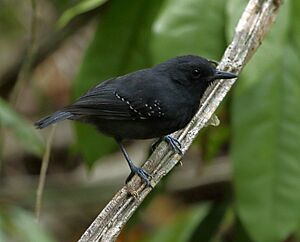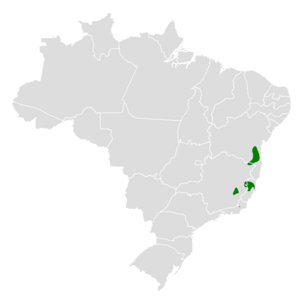Plumbeous antvireo facts for kids
Quick facts for kids Plumbeous antvireo |
|
|---|---|
 |
|
| Male | |
| Conservation status | |
| Scientific classification | |
| Genus: |
Dysithamnus
|
| Species: |
plumbeus
|
 |
|
The plumbeous antvireo (Dysithamnus plumbeus) is a small bird found only in Brazil. It's part of the "typical antbirds" family, known as Thamnophilidae. This bird is currently listed as a Vulnerable species. This means its numbers are going down, and it needs protection to survive in the wild.
Contents
About the Plumbeous Antvireo
What's in a Name?
The plumbeous antvireo got its scientific name, Dysithamnus plumbeus, a long time ago. Scientists sometimes change how birds are grouped as they learn more. For a while, this bird was thought to be the same as the white-streaked antvireo. But now, scientists agree they are different species. The plumbeous antvireo is considered a unique species, meaning it doesn't have different subspecies.
How to Spot a Plumbeous Antvireo
This bird is about 12 to 13 centimeters (5 inches) long. That's roughly the size of a small sparrow.
- Males: Adult males are mostly dark gray. Their head, back, and tail are dark gray. They have a hidden white patch on their back, near their shoulders. Their wings are black with white tips and edges. Their belly is a darker, blackish-gray.
- Females: Adult females look different. They have an olive-brown head and back. Their wings have buff-white spots. Their throat is very light gray. Their chest is olive-brown, and their belly is a yellowish-brown color.
Where Plumbeous Antvireos Live
Home Sweet Home: Brazilian Forests
The plumbeous antvireo lives in southeastern Brazil. You can find them in states like Bahia, Minas Gerais, Espírito Santo, and Rio de Janeiro. They prefer the Atlantic Forest, which is a special type of rainforest.
Their Favorite Places
These birds like to live in the lower parts of evergreen forests. They almost always live in forests that haven't been touched much by humans. They especially like overgrown spots, like where a tree has fallen and created an open space. They usually live below 600 meters (about 2,000 feet) in elevation. Sometimes, they can be found as high as 900 meters (about 3,000 feet).
Plumbeous Antvireo Behavior
Staying Put
Scientists believe the plumbeous antvireo stays in the same area all year long. It doesn't migrate to other places.
What's for Dinner?
The plumbeous antvireo mainly eats insects and other small creatures like spiders. They usually look for food alone or in pairs. Sometimes, they join a group of different bird species that are also looking for food.
They typically feed within 2 meters (about 6.5 feet) of the ground. But sometimes, they go higher, up to 4 meters (13 feet). They also look for food right on the ground. They mostly find food by picking insects off leaves, vines, and small branches while perched. They also search inside dead leaf clusters.
Reproduction and Life Cycle
Not much is known about how plumbeous antvireos raise their young. They are thought to breed between August and December. Only one nest has ever been found and studied. This nest was about 0.3 meters (1 foot) off the ground in a small bush. It had two eggs, and the female bird was sitting on them.
The Bird's Song
The plumbeous antvireo has a unique song. It's described as a "slow series of 6-8 evenly spaced, rising and falling, sad-sounding notes." You can listen to their song here:
Protecting the Plumbeous Antvireo
Why It's Vulnerable
The plumbeous antvireo is listed as a Vulnerable species by the IUCN. This means its population is decreasing. There are only an estimated 2,500 to 15,000 adult birds left.
The biggest threat to these birds is the loss of their forest home. Forests are being cut down for wood, firewood, and to make space for farms. Fires from farms can also spread into the forest and harm their habitat.
What Can Be Done?
This bird has never been very common. It's only found in a few small areas within its range. Luckily, it does live in a few protected areas. Scientists need to learn more about this bird's life and what it needs to survive. This information can help create plans to protect them and their forest homes.


